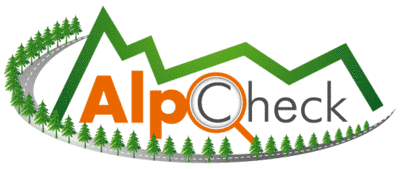 In AlpCheck 13 partners from 4 EU member states of the Alpine area (Austria, Germany, Italy and Slovenia) cooperate.OMEGA consult was included in the project consortium of AlpCheck1, as Slovene representative next to the University of Maribor, Faculty of Civil Engineering. The project that started in 2006 and ended in June 2008 was part of the Interreg IIIB programme – Alpine Space as the strategic project for mobility in the Alpine area. Cooperation on the project continues in AlpCheck2, where OMEGA consult is contracted by the Slovene Roads Agency, who is the consortium partner. Main goal of AlpCheck2 is the setup of an information system that will use existing data sources, combine them and assure comparability of all information in order to describe the actual (real time) road conditions in the Alpine road network.
In AlpCheck 13 partners from 4 EU member states of the Alpine area (Austria, Germany, Italy and Slovenia) cooperate.OMEGA consult was included in the project consortium of AlpCheck1, as Slovene representative next to the University of Maribor, Faculty of Civil Engineering. The project that started in 2006 and ended in June 2008 was part of the Interreg IIIB programme – Alpine Space as the strategic project for mobility in the Alpine area. Cooperation on the project continues in AlpCheck2, where OMEGA consult is contracted by the Slovene Roads Agency, who is the consortium partner. Main goal of AlpCheck2 is the setup of an information system that will use existing data sources, combine them and assure comparability of all information in order to describe the actual (real time) road conditions in the Alpine road network.
 The project ARTEMIS (Advanced Rational Transport Evaluator and Multimodal Information System) is co-funded by the European Commission under the program Marco Polo II. A consortium of eleven partners from Spain, France, Slovenia and Italy has set itself the challenging goal of building an information platform that could guide and support operators in the approaching path to intermodal transport.
The project ARTEMIS (Advanced Rational Transport Evaluator and Multimodal Information System) is co-funded by the European Commission under the program Marco Polo II. A consortium of eleven partners from Spain, France, Slovenia and Italy has set itself the challenging goal of building an information platform that could guide and support operators in the approaching path to intermodal transport.
ARTEMIS can be defined as a technologically advanced instrument for the evaluation of alternatives for the shipment of goods from origin to destination (door-to-door), which is able to indicate both the optimal load and paths for the road-only mode or the opportunities and conveniences of the multimodal transport alternatives. It can also be used to operate the optimal choice of unit load, the better exploitation of available space within the same unit in relation to the different situations: single-mode, multi-mode, or both.
ARTEMIS provides a clear view of the various options that may selected during the planning decision-making process. Different alternatives are weighted in terms of performance, cost and environmental efficiency, and helps to identify the optimal solution based on the priorities dictated by the user and displays it above the other alternatives considered less competitive.
